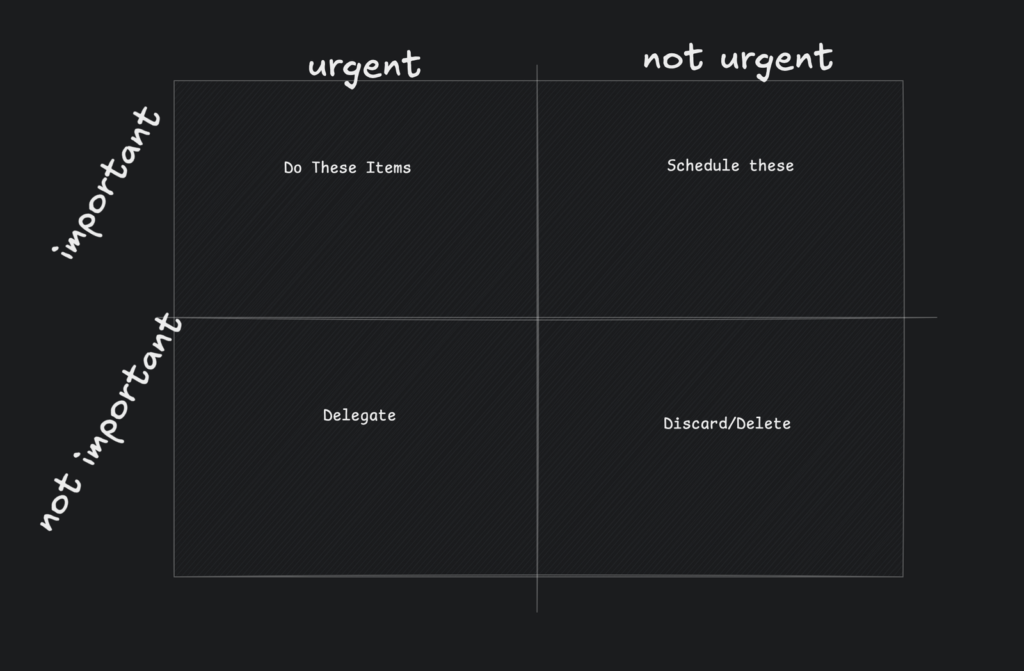The Eisenhower Matrix is a powerful tool for prioritizing tasks based on urgency and importance, helping engineers stay focused on what matters most. Here’s how to effectively use it in your daily work and delegate tasks efficiently.

The Matrix Breakdown
- Quadrant 1: Urgent & Important: Do these tasks immediately (e.g., critical bug fixes).
- Quadrant 2: Important, Not Urgent: Plan to do these later (e.g., long-term refactoring). Give them a date or deadline so they’re not forgotten, but don’t plan to actively work on them until Quadrant 1 items have been completed.
- Quadrant 3: Urgent, Not Important: Delegate these (e.g., repetitive data entry).
- Quadrant 4: Not Urgent, Not Important: Avoid or deprioritize (e.g., low-value distractions).
Daily Use in Engineering
- Start Your Day:
- List all tasks, including coding, debugging, and operational work.
- Categorize them into the four quadrants.
- Focus on Quadrant 1:
- Ensure critical work and strategic goals get your attention.
- Figure out Quadrant 2:
- These are great to set a deadline for that isn’t immediate.
- Delegate Quadrant 3:
- Assign setup or administrative tasks (e.g., creating accounts, updating spreadsheets) to support staff or possibly junior team members.
- Remove Items in Quadrant 4
- These should be de-prioritized.
Most of the time these are things like social meetings. Discussions that don’t need to immediately be taken to move forward billable work. Sometimes they’re tasks that are not impacting and can be removed from your mind for the sprint.
Can these tasks be moved to another sprint? Can they be added as a fast-follow after a deployment? Can they be removed entirely as a “wont do” because they’re unnecessary?
- These should be de-prioritized.
- Review Regularly:
- Reassess tasks daily to adapt to changing priorities. Day-to-day priorities can shift. Checking in regularly with Project Management or Product Managers can help you re-evaluate if there has been any shifting priorities.
Some Examples
Quadrant 1: Urgent & Important (Do Immediately)
- Fixing a production outage or critical bug.
- Reviewing a time-sensitive pull request blocking a release.
- Resolving broken CI/CD pipelines.
Quadrant 2: Important, Not Urgent (Plan to Do)
- Refactoring legacy code for better maintainability.
- Researching and proposing a new tech stack for a future project.
- Writing technical documentation for internal tools.
Quadrant 3: Urgent, Not Important (Delegate)
- Setting up user accounts or configuring environments.
- Gathering data for a report or presentation.
- Responding to non-critical support requests or inquiries.
Quadrant 4: Not Urgent, Not Important (Eliminate or Deprioritize)
- Engaging in prolonged Slack discussions about non-essential topics.
- Experimenting with a low-priority feature idea.
- Tweaking visual elements that don’t impact user experience or functionality.
Delegation Tips
- Clearly define expectations for tasks you delegate.
- Use templates or checklists to streamline repetitive work.
- Provide access to tools or training if the task is unfamiliar to the person you’re delegating to.
By leveraging the Eisenhower Matrix, you’ll maximize productivity, focus on impactful work, and empower your team to handle support tasks effectively. Start using it today to bring clarity and balance to your engineering workflow!

Leave a Reply